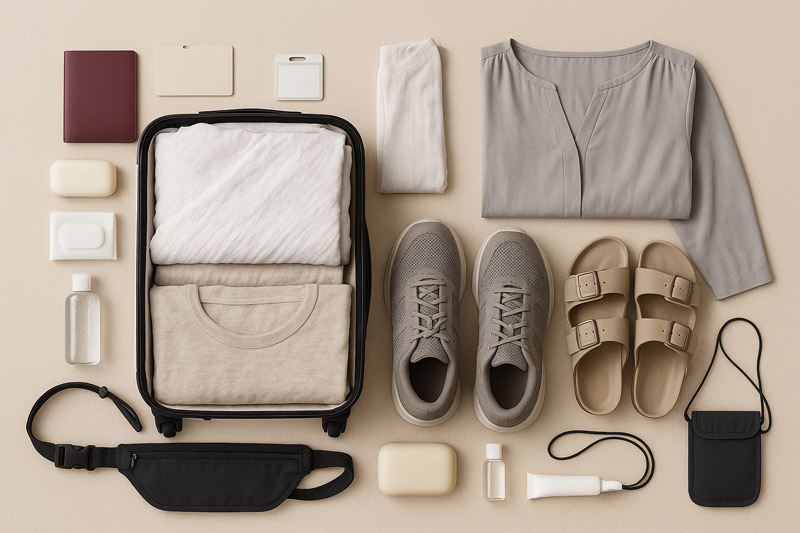Hajj is a unique and spiritual journey that millions of Muslims around the world prepare for each year. To ensure that this sacred experience is peaceful, worry-free, and enriching, proper preparation and awareness of important Hajj travel tips are essential. In this complete guide, we cover everything you need to know before your departure—from packing essentials and initial preparations to important tips during your stay in Saudi Arabia, along with specific cultural and safety advice for Iranian pilgrims. By following these tips, you can embark on your journey to the holy land with peace of mind and perform your rituals in full serenity.
What You Need to Know Before Departing for Hajj
- What is the difference between Hajj al-Tamattu’ and Hajj Ifrad?
- Pre-travel preparations for Hajj
- Packing checklist for Hajj
- Important tips for travel and stay in Saudi Arabia
- Practical advice for performing Hajj rituals
- Essential Hajj items for men
- Essential Hajj items for women
- Cultural and safety recommendations for Iranian pilgrims
- Post-Hajj care and recovery tips
🕋What’s the difference between Hajj Tamattu’ and Hajj Ifrad?
Hajj Tamattu’ is the most common type of Hajj for pilgrims coming from outside Mecca (like Iran). It involves performing Umrah first, then re-entering the state of Ihram a few days later for Hajj. Hajj Ifrad, on the other hand, is typically for locals of Mecca or surrounding areas, and includes only the Hajj rituals without a preceding Umrah (though a separate Umrah may be performed afterward). The main differences lie in the sequence of rituals, the number of times one must enter Ihram, and whether Umrah is required before Hajj.
| Feature |
Tamattu’ |
Ifrad |
Qiran |
| Intention at Ihram |
Umrah → then Hajj |
Only Hajj |
Umrah + Hajj together |
| Number of Ihrams |
Two times |
One time |
One time |
| Exit from Ihram between rituals |
✅ Yes |
❌ No |
❌ No |
| Tawaf and Sa’i |
Separate for Umrah and Hajj |
Tawaf al-Qudum + one Sa’i |
One Tawaf and Sa’i for both rituals combined |
| Sacrifice (Qurbani) |
✅ Mandatory |
❌ Recommended only |
✅ Mandatory |
| Suitable for |
Pilgrims from outside Mecca |
Residents of Mecca |
Experienced pilgrims performing both with sacrifice |
Pre-Departure Preparation for Hajj
Spiritual Preparation
- A sincere intention and practicing patience are essential pillars of spiritual readiness.
- Study the Hajj rituals and rulings beforehand or attend Hajj training sessions if possible.
Physical and Medical Preparation
- Consult your doctor and ensure you receive required vaccines such as meningitis and COVID-19.
- If you have pre-existing health conditions, bring your medications and prescriptions.
- Choose lightweight, breathable, and comfortable shoes—you’ll be walking a lot during Hajj.
Learning the Rituals
- Use Farsi apps like “Manasik-e-hajj” or “Zaer” to study the rituals effectively.
- Bring a small notebook to jot down key notes, prayers, and reminders.
Checklist of Essential Items for Hajj Travel
When searching terms like “Hajj packing list” or “Tamattu Hajj items” online, you’ll find many suggestions. However, these items are essential:
- Important Documents: Passport, vaccination card, caravan ID
- Clothing: Ihram garments, lightweight abaya or chador, comfortable cotton clothing for Mecca and Medina
- Hygiene items: Unscented soap, wet wipes, hand sanitizer, face masks, burn cream
- Gear: Walking shoes, sandals, or slippers for ablution, a belt bag, or a neck pouch for valuables

Important Tips During Travel and Stay in Saudi Arabia
✈️ At the Airport and During the Flight
- Arrive on time and safeguard all your documents.
- Remove prohibited items such as perfumes, codeine-based medicines, or unauthorized devices from your luggage.
- Stay calm and coordinated with your caravan from departure until hotel check-in.
🕌 In Mecca and Medina
- Learn the location of your accommodation and its routes to the mosque.
- Manage the crowds and avoid excessive night prayers that may exhaust you.
- Visit during quieter hours, like before the Fajr prayer, to avoid congestion.
Practical Tips While Performing Hajj Rituals
- Always carry your ritual guidebook or app with you.
- For Tawaf and Sa’i: Stay calm and don’t rush, even in crowded areas.
- For stoning (Rami al-Jamarat): Be cautious of crowd pressure and heat exhaustion.
- Drink Zamzam water in moderation to stay hydrated and energized.
- Learn key terms like Ihram, Arafat, Muzdalifah, Mina, and animal sacrifice for better understanding.
Essential Hajj Items for Men
- Ihram clothing(two unstitched pieces): Bring an extra set.
- Walking shoes or sandals: Stitch-free, lightweight, and comfortable for long walks on hot surfaces.
- Small pouch or neck wallet: For holding documents, money, and keys.
- Permitted shaving tools: Razors or electric trimmers following hygiene rules.
- Comfortable non-Ihram clothes: Preferably light-colored and breathable.
- Fragrance-free towel: For use after showering.
📌 Important Note: Men are not allowed to wear stitched clothing during Ihram. Non-Ihram clothes are only for before and after the state of Ihram.
Essential Hajj Items for Women
- Light, breathable abaya or chador: Preferably plain and without bright colors.
- Comfortable cotton undergarments: Bring multiple sets due to sweating.
- Extra cotton scarves or head coverings: Bring several for daily changes.
- Cotton or special Hajj socks: For comfort and foot protection.
- Fragrance-free sunscreen, heel balm, moisturizers: To protect sensitive skin from the heat.
- Cloth pouch or bag for essentials: Avoid real leather materials during Ihram.
📌 Important Note: Women should wear clothing that is both modest and suitable for hot climates—preferably items that dry quickly and don’t take up much luggage space.
Cultural and Safety Advice for Iranian Pilgrims
- Respect local customs regarding dress and behavior in Saudi Arabia.
- Avoid engaging in religious or political debates.
- When shopping or buying souvenirs, compare prices and avoid very crowded areas.
- Always carry emergency contact numbers and hotel information.
- Use only official caravan apps like “Rahiyan Hajj” or “Zaer Hamrah.”
Post-Hajj Health and Care
- Your body will need rest after returning—avoid intense activity for a few days.
- Watch for symptoms of viral illness, and see a doctor if you experience fever or fatigue.
Conclusion
Following these Hajj travel tips can significantly enhance the quality of your spiritual journey. From packing essentials and carrying proper documentation to understanding medical, cultural, and safety advice, every detail helps ensure a smooth, meaningful pilgrimage. With proper planning, caravan coordination, and learning from the experience of past pilgrims, you can make the most of every moment of this sacred path.
FAQs – Hajj Travel Tips
What items should I bring for Hajj?
You should bring items such as Ihram clothing, essential medications, comfortable shoes, a Qur’an, and personal hygiene items. Be sure to review a complete packing list before you travel.
When is the best time to perform Hajj Tamattu’?
Hajj Tamattu’ can only be performed during the Islamic month of Dhu al-Hijjah (according to the lunar calendar). The exact departure time depends on your caravan and national schedule.
How can I avoid heat and fatigue during Hajj?
Drink plenty of water, use an umbrella, wear breathable cotton clothes, and take enough rest to avoid heat exhaustion.
What religious rules must be followed during Hajj?
Maintaining proper intention, cleanliness, avoiding forbidden acts during Ihram, and following the guidance of scholars and caravan leaders are crucial. Familiarize yourself with Hajj rulings before your trip.
Are there any mandatory vaccines for Hajj?
Yes, the meningitis vaccine is mandatory. Depending on the circumstances, COVID-19 and other vaccines may also be required.

